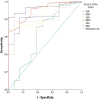Decoding Inflammation: Predicting Sepsis in the ICU
- PMID: 39776743
- PMCID: PMC11703654
- DOI: 10.7759/cureus.75256
Decoding Inflammation: Predicting Sepsis in the ICU
Abstract
Background: Sepsis is a life-threatening condition arising from a dysregulated host response to infection leading to organ dysfunction. Traditional clinical signs are often unreliable for detecting sepsis, necessitating the exploration of more accurate biomarkers. Furthermore, currently, recommended screening scores perform poorly, necessitating more effective biomarkers to identify sepsis. Therefore, in this study, we evaluated the predictive capabilities of six inflammatory biomarkers - C-reactive protein (CRP), red cell distribution width (RDW), neutrophil-lymphocyte ratio (NLR), monocyte distribution width (MDW), mean neutrophil volume (MNV), and mean monocyte volume (MMV) - measured from samples taken for complete blood count (CBC) for the development of sepsis in ICU patients.
Methods: We conducted a prospective observational study involving ICU patients at a tertiary-care hospital in Hyderabad, India, over a one-year period to primarily assess the predictability of these six biomarkers for sepsis. As a secondary outcome, we also analyzed the predictiveness of the biomarkers with respect to mortality, the need for vasopressors, invasive mechanical ventilation or renal replacement therapy (RRT), the presence of organ failure, and hospital length of stay. Blood samples were collected for CRP and CBC on the first day of admission, from which RDW, NLR, MDW, MNV, and MMV were measured. Demographic data, including Acute Physiology and Chronic Health Evaluation II (APACHE II) and Sequential Organ Failure Assessment (SOFA) scores, clinical progression (recovery or mortality), requirement for vasopressors, invasive mechanical ventilation, RRT, presence of organ failure, and overall length of hospital stay, were documented.
Results: We analyzed data from 84 patients after one patient withdrew consent. The study sample had a mean age of 65.83 years, with 60 (71.4%) patients >60 years of age and a male predominance (n = 50; 59.5%). About 57 (67.85%) patients had three or more comorbidities. About 71 (84.5%) patients met the sepsis-3 criteria. Mean APACHE II and SOFA scores were 18.73 and 5.36, respectively. Primary outcome analysis showed that CRP and MDW were the most sensitive, with sensitivities of 81.75% and 81.7%, respectively, whereas MDW, MNV, and MMV had the highest specificity at 100% each. Correlation analysis revealed that MDW had the best area under the curve (AUC) of 0.932 in predicting sepsis. Multivariate logistic regression identified both MDW and MMV to have a significant positive correlation in the prediction of sepsis. The overall mortality rate was 9.5%. About 82 (97.6%) patients had organ failure, 35 (41.7%) required vasopressors, 20 (23.8%) required invasive mechanical ventilation, 16 (19%) required RRT, and 59 (70.2%) had a hospital stay exceeding five days, with an average length of hospital stay of eight days. No biomarkers showed strong AUC or specificity compared to the SOFA score (0.710, 94.74% specificity in predicting mortality). However, among the six biomarkers, MDW was the most specific (86.84%). A CRP of >65 mg/L was the best indicator for prolonged hospital stay, vasopressor use, and RRT. An MMV of >179 and MDW of >21.86 U were the most sensitive markers for vasopressor requirements.
Conclusion: Our findings suggest that easily accessible biomarkers derived from routine CBC tests, particularly MDW and MMV, may serve as valuable tools for early sepsis diagnosis in resource-limited settings.
Keywords: biomarkers in sepsis; early sepsis; inflammatory biomarker; inflammatory biomarkers for the development of sepsis in icu; mean monocyte volume (mmv); monocyte distribution width (mdw); resource limited setting; sepsis prediction.
Copyright © 2024, Chandrabhatla et al.
Conflict of interest statement
Human subjects: Consent for treatment and open access publication was obtained or waived by all participants in this study. Institutional Ethics Committee of Citizens Specialty Hospital issued approval ECR/1103/Inst/TG/2018/RR-21. Animal subjects: All authors have confirmed that this study did not involve animal subjects or tissue. Conflicts of interest: In compliance with the ICMJE uniform disclosure form, all authors declare the following: Payment/services info: All authors have declared that no financial support was received from any organization for the submitted work. Financial relationships: All authors have declared that they have no financial relationships at present or within the previous three years with any organizations that might have an interest in the submitted work. Other relationships: All authors have declared that there are no other relationships or activities that could appear to have influenced the submitted work.
Figures


References
-
- Use of the SOFA score to assess the incidence of organ dysfunction/failure in intensive care units: results of a multicenter, prospective study. Working group on "sepsis-related problems" of the European Society of Intensive Care Medicine. Vincent JL, de Mendonça A, Cantraine F, et al. Crit Care Med. 1998;26:1793–1800. - PubMed
-
- Early sepsis detection in critical care patients using multiscale blood pressure and heart rate dynamics. Shashikumar SP, Stanley MD, Sadiq I, Li Q, Holder A, Clifford GD, Nemati S. https://doi.org/10.1016/j.jelectrocard.2017.08.013. J Electrocardiol. 2017;50:739–743. - PMC - PubMed
-
- Utility of the serum C-reactive protein for detection of occult bacterial infection in children. Isaacman DJ, Burke BL. Arch Pediatr Adolesc Med. 2002;156:905–909. - PubMed
LinkOut - more resources
Full Text Sources
Research Materials
Miscellaneous
